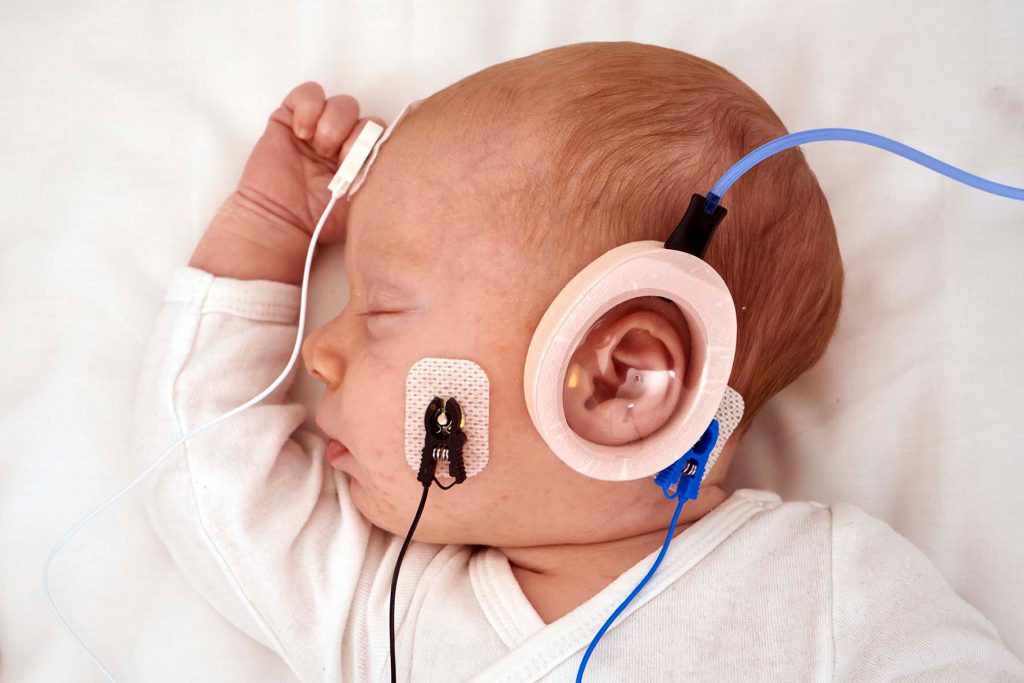Have you ever wondered how sound travels from your ears to your brain, creating the symphony of sensations we call hearing? The Auditory Brainstem Response (ABR) test offers a fascinating glimpse into this intricate process. In this blog post, we’ll dive deep into ABRs, exploring what they are, who needs them, and how they help diagnose hearing issues.
What is an ABR Test?
Imagine your ear as a microphone, your auditory nerve as a cable, and your brainstem as the control center. The ABR test essentially “hacks” into this system, measuring the electrical activity generated by your brainstem in response to sound stimuli. This activity, recorded through electrodes placed on your head, forms a unique waveform that reveals the health and efficiency of your hearing pathway.

Purpose and Procedure
The primary purpose of an ABR test is to:
- Diagnose hearing loss, especially in infants and young children who can’t perform traditional hearing tests.
- Identify the location of hearing loss, whether in the inner ear, auditory nerve, or brainstem.
- Monitor the effectiveness of hearing aids or cochlear implants.
The procedure itself is painless and non-invasive. You lie down in a quiet room, electrodes are attached to your head and behind your ears, and you’ll hear clicking, or tone sounds played through headphones or tiny bone vibrators. The entire test takes about 30-60 minutes.
Who Needs an ABR Test?
While anyone can benefit from an ABR test, it’s particularly recommended for:
- Newborn babies, especially those at risk for hearing loss due to prematurity, low birth weight, or certain genetic conditions.
- Infants and young children who fail traditional hearing screenings.
- Individuals with suspected hearing loss, especially if they have difficulty understanding speech in noisy environments.
- People with balance or dizziness issues that may be related to inner ear problems.
- Patients undergoing treatment for conditions that could affect hearing, such as tumors or nerve damage.
Types of ABR Tests
There are two main types of ABR tests:
- Air-conducted: Sounds are presented through headphones. This tests the entire hearing pathway, from the outer ear to the brainstem.
- Bone-conducted: Sounds are transmitted directly to the inner ear through vibrations on the skull bone. This bypasses the outer and middle ear, helping to identify the location of hearing loss.
In addition to the type of stimulus used, ABR tests can also differ in the specific sounds they employ. Clicks are commonly used for infants and young children, while tones of varying frequencies are used for adults and older children.
Interpreting ABR Results
The ABR results are displayed as a waveform with peaks and troughs. Each peak represents electrical activity generated by a different part of the auditory pathway. A typical ABR waveform shows distinct peaks within specific timeframes. Any abnormalities, such as missing or delayed peaks, can indicate hearing loss or damage at particular points in the pathway.
Limitations and Considerations
While ABR tests are a valuable tool, it’s important to remember their limitations:
- Accuracy: They may not be 100% accurate, especially in infants or individuals with neurological conditions.
- Factors affecting results: Fatigue, sleepiness, and background noise can influence results.
- Alternative tests: Other tests like Otoacoustic Emissions (OAEs) Test or Tympanometry test may be used in conjunction with ABRs for a more comprehensive assessment.
Conclusion
The ABR test offers a unique window into the intricate workings of our hearing system. Understanding its purpose, procedure, and limitations allows you to make informed decisions about your hearing health and seek appropriate care. If you have any concerns about your hearing, consult an audiologist or other hearing healthcare professional. They can guide you through the ABR test process and help you interpret the results to ensure optimal hearing health.
You may also like
-
Effortless Pigmentation Mark Removal: Exploring the Benefits of Yellow Laser Treatment
-
Pelvic Mesh Implants: What You Should Know About Potential Side Effects
-
How to Recover From a Foot Injury
-
Finding Balance: 7 Stores Offering the Best Traditional Chinese Medicine for Stress Relief
-
Sildisoft 100 and Valentine’s: Crafting Moments of Love

